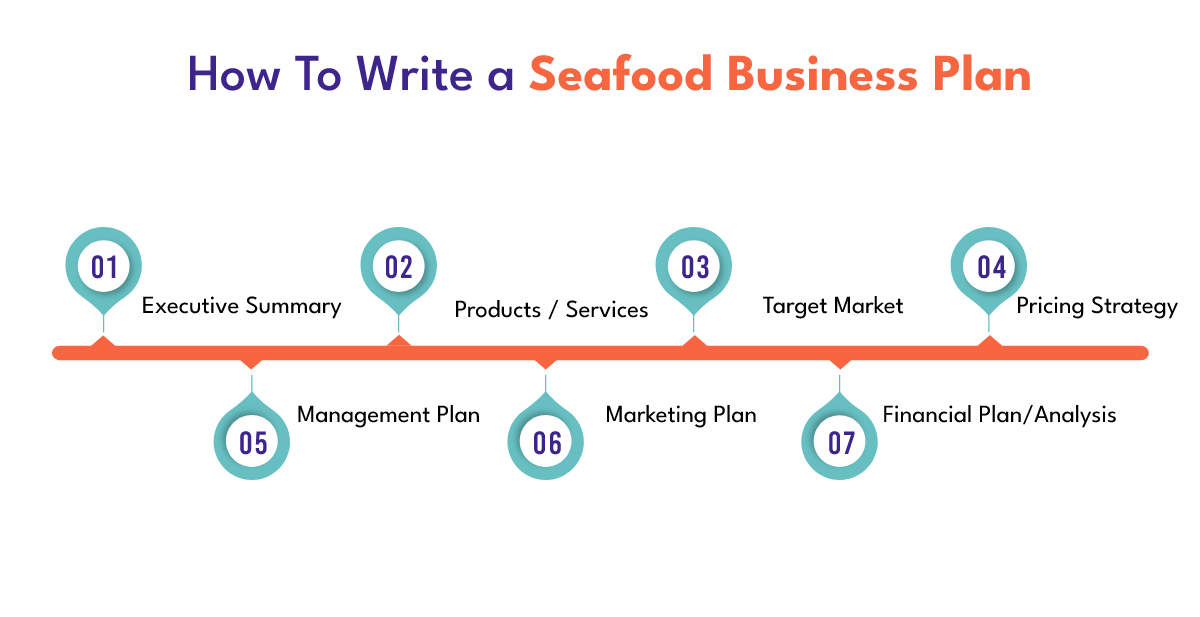How to Start a Seafood Business
Seafood is known to be a healthy option for consumers looking to modify eating habits and control calories, but seafood market owners are reporting a sharp increase in consumption due to warm weather and current seasonal fishing options.
- 1. Develop a Seafood Business Plan
- 2. Learn about Food-Service Regulations
- 3. Find the Perfect Location
- 4. Start your Paperwork
- 5. Manage your Legal Compliance
- 6. Create a legal business entity
- 7. Contact your Stakeholders
- Seafood Market Business Plan (Seafood Restaurant Business Plans)
- Seafood Restaurant Business Plan
- FAQs:
The seafood market is a major source of protein in many markets, and it is a favorite food item among all consumers regardless of the price range.
We developed this guide to help people who are interested in starting a seafood business. You can start your own seafood business by following these 7 simple steps:

1. Develop a Seafood Business Plan
Write a business plan if you want to run a business and achieve your goals. Basically, a business plan describes the goals and objectives of a company and outlines how those goals will be achieved.
Writing a business plan has several advantages. Financial institutions usually require a business plan to evaluate a business proposal and offer funding.
Business plans are required by some cities for building permits, zoning permits, and occupancy certificates.
Furthermore, writing a business plan will help you turn your ideas into reality as well as discover any complications or important details that you may have overlooked.
This is the outline of a business plan. There is no right or wrong way to write a business plan, but following these steps will help you get started.
- Executive Summary: The executive summary should be the first part of your business plan. This part should be Well-written, concise, and easy to understand. It should grab the reader’s attention.Outline your plan and how you will accomplish it. Describe your strategy, including your business purpose, target market, management plan, financial agenda, etc.
- Products / Services: Describe your product or service in detail. Describe the product’s appearance, its uniqueness, its advantages, and/or disadvantages. Talk about what makes your product unique.
- Target market: Identify your target market. It won’t be for everyone. Think about who will buy this. Find out as much as you can about your target market’s demographics. Consider how your product or service will benefit your customers over your competitors’.
- Pricing Strategy: Are you planning to maintain a flexible pricing strategy? Are you planning to offer a better price than your competitors?
- Management Plan: Describe how your business will be run. Provide information regarding purchasing, inventory, insurance, labor, and other relevant business information.
- Marketing Plan: It is also critical to have a comprehensive marketing plan. Advertisement is an essential part of running a seafood business; therefore, you must do it wisely. Set up your marketing budget. Media outlets like radio and newspapers play a significant role in local communities.
- Financial Plan/Analysis: This is where you put all the financial details and forecasts. Costs associated with startup – such as equipment, reconstruction, furniture, painting, rent, startup labor, trade license, etc. You may also want to include legal and consulting fees. Basically, any costs associated with opening a seafood restaurant or distribution business.
Do You Need Help in Creating a Seafood Business Plan?
Business plan writing has never been easier for our clients. Our MBA-qualified business plan writers have written more than 15000 business plans for over 400 industries in over a decade.
2. Learn about Food-Service Regulations
There is a good chance that your state, city, or county will require your managers and staff to attend food handling workshops. A food service license usually requires this.
3. Find the Perfect Location
Having your customers and suppliers reach you easily is key to running a successful business. The increasing demand for food delivery from consumers means that you need to figure out how many users are nearby.
4. Start your Paperwork
Registrations, licenses, and clearances are necessary for conducting business. There are different requirements depending on your jurisdiction, but generally, a business license or business tax receipt is required from your country or state government.
Want to Register your Business and get a License for Seafood Business?
Wisebusinessplans provides a wide range of business formation services to help you From an LLC, corporation and obtain a business license.
Let Wise help you to Get a Seafood Business License and Register your Seafood Business
5. Manage your Legal Compliance
Your seafood business must comply with both federal and state regulations. In terms of the federal government, you need to familiarize yourself with the inspection and sanitation requirements specific to the seafood industry set by the Food and Drug Administration.
6. Create a legal business entity
When you form a business entity, your personal assets are protected from business lawsuit judgments. To form a corporation, visit the secretary of state’s website in your state.
Obtain a (free) Employer Identification Number from the IRS once you have incorporated at the state level. In writing your seafood business plan, consult a tax advisor to determine the type of corporation you should become at the federal level.
7. Contact your Stakeholders
Every business needs a steady stream of customers and a network of reliable suppliers. If you own a seafood restaurant, conduct focus groups of your target customers to determine what they think about the seafood business ideas you have.
Get to know local restaurant owners and seafood vendors, including fishing boat operators. If you plan to open a restaurant, you should have a marketing and advertising plan. Make sure you have backup suppliers in case your primary vendors are unable to fulfil your orders. Check that all your vendors have the necessary (and multiple) seafood licenses.
Seafood Market Business Plan (Seafood Restaurant Business Plans)
Before a seafood market business plan is crafted for a particular client, the Wise team of professional business plan writers carefully listens and consults with the business owner to ensure that all pertinent information is included and the resulting plan will meet the unique ideas and goals of the client.
All business plans include professional and personal financial planning and are always offered at an affordable price.
“Today, there is an amazing variety of quality seafood available to the public, and people are appreciative of the opportunity to experience these different tastes and textures,” said Joseph Ferriolo, Director of Wise. “At Wise, we understand the value of options.
We offer each of our clients an opportunity to achieve a high degree of success through the use of effective seafood business plan strategies. We really want them to have a quality business life.”
Seafood Restaurant Business Plan
Would you like to open your own restaurant and earn a profit by demonstrating your culinary skills? As long as you choose the location wisely, starting a seafood business can be extremely profitable.
You’ll just need to hire the right employees and establish contacts with seafood vendors and suppliers.
“A seafood market is a unique, seasonal environment and, as such, must have its seafood business plan needs to be met in an equally unique manner. Our Wisebusinessplans team of writers and designers has the experience and integrity to expertly meet those needs,” said Ferriolo.
You can download our free Seafood business plan sample in PDF format or visit our business plan samples page to see our real sample business plans related to over 400 industries.
FAQs:
Starting a seafood business involves several key steps, including conducting market research, creating a business plan, securing necessary permits and licenses, sourcing seafood suppliers, setting up a suitable location, and implementing effective marketing strategies.
There are various types of seafood businesses you can start, such as a seafood restaurant, a seafood market or fishmonger, a seafood food truck, a seafood processing or packaging business, or an online seafood delivery service.
Finding reliable seafood suppliers involves conducting thorough research, establishing relationships with local fishermen, attending seafood trade shows or industry events, and verifying the suppliers’ certifications and quality standards.
To ensure freshness and quality, source seafood from reputable suppliers known for their commitment to quality. Maintain proper storage conditions, follow proper handling and refrigeration protocols, and implement rigorous quality control measures.
Creating a unique seafood menu or product selection involves offering a variety of fresh seafood options, including popular choices and unique or seasonal selections. Consider customer preferences, local seafood specialties, and diverse cooking techniques.












